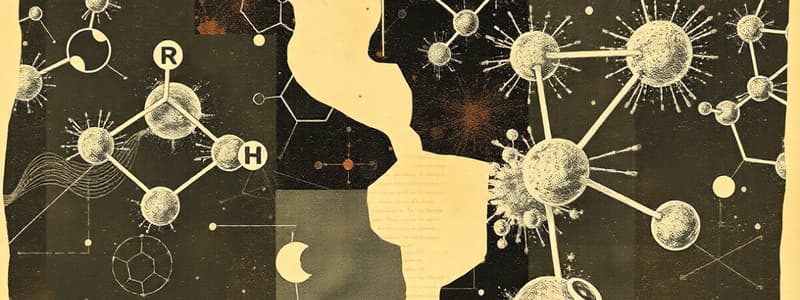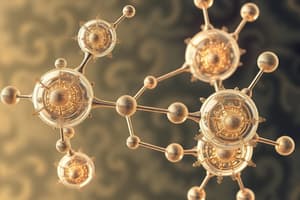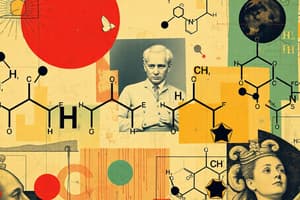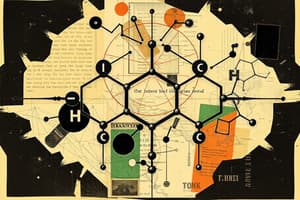Podcast
Questions and Answers
Why is achieving a full outermost electron shell crucial for atoms when forming chemical bonds?
Why is achieving a full outermost electron shell crucial for atoms when forming chemical bonds?
- It increases the atom's reactivity with noble gases.
- It minimizes the atom's potential energy, leading to stability. (correct)
- It maximizes the atom's kinetic energy.
- It allows the atom to repel other atoms more effectively.
In biological systems, why is water considered such a crucial inorganic compound?
In biological systems, why is water considered such a crucial inorganic compound?
- It directly encodes genetic information for protein synthesis.
- It provides building blocks to synthesize organic molecules.
- It serves as a solvent, participates in reactions, and helps regulate temperature. (correct)
- It acts as a universal energy source for cellular processes.
How does the structure of ATP enable it to function as the primary energy transfer molecule in cells?
How does the structure of ATP enable it to function as the primary energy transfer molecule in cells?
- It possesses high-energy phosphate bonds that, when broken, release energy. (correct)
- It is a large, complex molecule that traps energy from the environment.
- It contains stable covalent bonds that store large amounts of energy.
- It has a nitrogenous base that can directly bind to enzymes.
What is the role of enzymes as biological catalysts in the body, and why are they considered essential?
What is the role of enzymes as biological catalysts in the body, and why are they considered essential?
If a solution has a pH of 3, how would you best describe its acidity or alkalinity, and what does this indicate about the concentration of hydrogen ions?
If a solution has a pH of 3, how would you best describe its acidity or alkalinity, and what does this indicate about the concentration of hydrogen ions?
What distinguishes organic compounds from inorganic compounds, and why is this distinction biologically significant?
What distinguishes organic compounds from inorganic compounds, and why is this distinction biologically significant?
How do DNA and RNA collaborate to direct body structure and function through protein synthesis?
How do DNA and RNA collaborate to direct body structure and function through protein synthesis?
In the context of solutions, how do solvents and solutes interact, and why is this interaction crucial in biological systems?
In the context of solutions, how do solvents and solutes interact, and why is this interaction crucial in biological systems?
What is the fundamental role of lipids, and what are the primary functions of triglycerides, phospholipids, and steroids?
What is the fundamental role of lipids, and what are the primary functions of triglycerides, phospholipids, and steroids?
How does the process of hydrolysis break down larger molecules, and why is this process essential in biological systems?
How does the process of hydrolysis break down larger molecules, and why is this process essential in biological systems?
What are the key structural differences between DNA and RNA?
What are the key structural differences between DNA and RNA?
If a patient is diagnosed with acidosis, what does this indicate about their blood pH levels?
If a patient is diagnosed with acidosis, what does this indicate about their blood pH levels?
How do ionic and covalent bonds differ in terms of electron involvement, and what effect does these differences have on the resulting compounds?
How do ionic and covalent bonds differ in terms of electron involvement, and what effect does these differences have on the resulting compounds?
What distinguishes proteins from lipids, carbohydrates, and nucleic acids at the molecular level?
What distinguishes proteins from lipids, carbohydrates, and nucleic acids at the molecular level?
What is the approximate normal pH of blood, and why is maintaining this pH range crucial for bodily functions?
What is the approximate normal pH of blood, and why is maintaining this pH range crucial for bodily functions?
If a substance is identified as an electrolyte, what functional role does it typically play?
If a substance is identified as an electrolyte, what functional role does it typically play?
How do changes in hydrogen and hydroxide ion concentrations affect the acidity or alkalinity of a solution?
How do changes in hydrogen and hydroxide ion concentrations affect the acidity or alkalinity of a solution?
Explain how the diverse roles of functional proteins contribute to the body's processes.
Explain how the diverse roles of functional proteins contribute to the body's processes.
What is the basic structure of carbohydrates, and what role do they primarily play in energy storage?
What is the basic structure of carbohydrates, and what role do they primarily play in energy storage?
How would you explain the central role of DNA in directing the precise assembly of proteins during protein synthesis?
How would you explain the central role of DNA in directing the precise assembly of proteins during protein synthesis?
How do electrolytes facilitate electrical conductivity in solutions?
How do electrolytes facilitate electrical conductivity in solutions?
What role do hydrogen bonds play in stabilizing the structure of large biomolecules like proteins and DNA?
What role do hydrogen bonds play in stabilizing the structure of large biomolecules like proteins and DNA?
How does the ratio of hydrogen to hydroxide ions determine the pH of a solution?
How does the ratio of hydrogen to hydroxide ions determine the pH of a solution?
Why is the presence of both carbon and hydrogen generally essential for a compound to be classified as organic?
Why is the presence of both carbon and hydrogen generally essential for a compound to be classified as organic?
How do enzymes facilitate biochemical reactions within living organisms?
How do enzymes facilitate biochemical reactions within living organisms?
What structural feature enables carbon to create a vast diversity of organic compounds?
What structural feature enables carbon to create a vast diversity of organic compounds?
In what scenario would a buffer be most effective in maintaining a stable pH?
In what scenario would a buffer be most effective in maintaining a stable pH?
How does the process of hydrolysis contribute to the breakdown of polymers?
How does the process of hydrolysis contribute to the breakdown of polymers?
How does the sequence of nucleotides in DNA relate to protein synthesis?
How does the sequence of nucleotides in DNA relate to protein synthesis?
How does the interaction between a solute and a solvent lead to the formation of a solution?
How does the interaction between a solute and a solvent lead to the formation of a solution?
What impact does increasing the temperature typically have on the rate of a chemical reaction, and why?
What impact does increasing the temperature typically have on the rate of a chemical reaction, and why?
How does the arrangement of phospholipids in a cell membrane contribute to its function?
How does the arrangement of phospholipids in a cell membrane contribute to its function?
How does the presence of neutrons in the nucleus of an atom affect its chemical properties?
How does the presence of neutrons in the nucleus of an atom affect its chemical properties?
What determines whether a chemical bond between two atoms will be ionic rather than covalent?
What determines whether a chemical bond between two atoms will be ionic rather than covalent?
How does the structure of RNA differ from that of DNA, influencing their respective functions?
How does the structure of RNA differ from that of DNA, influencing their respective functions?
What role do buffers play in biological systems in relation to pH levels?
What role do buffers play in biological systems in relation to pH levels?
How does the unique structure of a protein relate to its specific function?
How does the unique structure of a protein relate to its specific function?
How does the concentration gradient of ions across a cell membrane contribute to cellular processes?
How does the concentration gradient of ions across a cell membrane contribute to cellular processes?
What determines the specific properties of different elements?
What determines the specific properties of different elements?
What is the role of nucleic acids, such as DNA and RNA, within a cell?
What is the role of nucleic acids, such as DNA and RNA, within a cell?
Flashcards
Elements
Elements
Substances with only one type of atom.
Compounds
Compounds
Substances with multiple chemically combined elements.
Atom
Atom
The smallest unit of matter.
Molecule
Molecule
Signup and view all the flashcards
Energy Levels
Energy Levels
Signup and view all the flashcards
Chemical Bonds
Chemical Bonds
Signup and view all the flashcards
Ionic Bonds
Ionic Bonds
Signup and view all the flashcards
Covalent Bonds
Covalent Bonds
Signup and view all the flashcards
Hydrogen Bonds
Hydrogen Bonds
Signup and view all the flashcards
Electrolytes
Electrolytes
Signup and view all the flashcards
Ions
Ions
Signup and view all the flashcards
Organic Compounds
Organic Compounds
Signup and view all the flashcards
Solvent
Solvent
Signup and view all the flashcards
Solute
Solute
Signup and view all the flashcards
pH
pH
Signup and view all the flashcards
Acidic
Acidic
Signup and view all the flashcards
Alkaline (Basic)
Alkaline (Basic)
Signup and view all the flashcards
Acidosis
Acidosis
Signup and view all the flashcards
Proteins
Proteins
Signup and view all the flashcards
Lipids
Lipids
Signup and view all the flashcards
Catalyst
Catalyst
Signup and view all the flashcards
Hydrolysis
Hydrolysis
Signup and view all the flashcards
Nucleic Acid
Nucleic Acid
Signup and view all the flashcards
Nucleotide
Nucleotide
Signup and view all the flashcards
Nucleus (of an atom)
Nucleus (of an atom)
Signup and view all the flashcards
Alkalosis
Alkalosis
Signup and view all the flashcards
RNA (Ribonucleic Acid)
RNA (Ribonucleic Acid)
Signup and view all the flashcards
Carbohydrate
Carbohydrate
Signup and view all the flashcards
DNA (Deoxyribonucleic Acid)
DNA (Deoxyribonucleic Acid)
Signup and view all the flashcards
Inorganic Compound
Inorganic Compound
Signup and view all the flashcards
Neutron
Neutron
Signup and view all the flashcards
Proton
Proton
Signup and view all the flashcards
Electron
Electron
Signup and view all the flashcards
Solution
Solution
Signup and view all the flashcards
Study Notes
Fundamental Building Blocks
- An atom is the fundamental unit of a chemical element, consisting of a nucleus with protons and neutrons, surrounded by electrons.
- Elements are substances whose atoms all have the same number of protons and cannot be broken down chemically.
- Compounds are formed when two or more chemical elements are chemically bonded together.
- Atoms join to form molecules, which are electrically neutral groups of two or more atoms held together by chemical bonds.
- Electrons are arranged around the nucleus in energy levels, which are regions around the nucleus that electrons with a specific range of energies can occupy.
- Atoms have a nucleus with protons and neutrons.
- Protons are stable subatomic particles with a positive electric charge found in the atomic nucleus
- Neutrons are subatomic particles of about the same mass as a proton but without an electric charge, present in the nuclei of atoms
- Electrons are stable subatomic particles with a negative electric charge.
- Energy changes with distance from the nucleus.
Chemical Bonding and Reactions
- Atoms form chemical bonds to achieve atomic stability.
- A chemical bond is an attraction between atoms or ions that allows the formation of chemical substances.
- Ionic bonds involve the transfer of electrons and are formed through an electrostatic attraction between oppositely charged ions.
- Covalent bonds involve the sharing of electrons.
- Hydrogen bonds are weaker bonds based on electromagnetic attraction between a hydrogen atom covalently bonded to a highly electronegative atom and another electronegative atom.
- Electrolytes are substances that produce an electrically conducting solution when dissolved in a polar solvent.
- Ions are charged atoms or molecules in which the total number of electrons is not equal to the total number of protons.
- Electrolytes and ions are significant in biological systems.
- Organic compounds contain carbon and hydrogen atoms covalently bonded together.
- Inorganic compounds do not primarily contain carbon and hydrogen atoms.
- Solvents dissolve solutes, resulting in a solution.
- Solutes are dissolved by solvents in a solution
- A solution is a homogeneous mixture composed of two or more substances.
- Water is a crucial inorganic compound in living organisms.
- A catalyst increases the rate of a chemical reaction without undergoing any permanent chemical change. Enzymes are biological catalysts.
- Hydrolysis is a chemical reaction in which a molecule is cleaved into two parts by the addition of a molecule of water.
Acids, Bases, and pH
- pH measures the acidity or basicity of an aqueous solution
- pH is the negative logarithm (base 10) of the activity of the hydrogen ion (H⁺).
- Lower pH values indicate higher acidity (more H+).
- Higher pH values indicate higher alkalinity (more OH-).
- Alkaline (Basic) solutions have a pH greater than 7, indicating a lower concentration of hydrogen ions (H⁺) and a higher concentration of hydroxide ions (OH⁻).
- Changes in hydrogen and hydroxide ion concentrations affect the acidity or alkalinity of a solution.
- Acidosis is a condition where blood pH is too low. It is characterised by an excessively low pH in the blood and other body tissues.
- Alkalosis is a condition where blood pH is too high and is characterised by an excessively high pH in the blood and other body tissues.
Major Organic Molecules
- Proteins are composed of amino acids linked by peptide bonds. They perform a vast array of functions within living organisms.
- Lipids are composed of glycerol and fatty acids and are insoluble in water but soluble in nonpolar organic solvents.
- Major types of lipids include triglycerides, phospholipids, and steroids.
- Lipids function in energy storage and insulation.
- Carbohydrates are composed of carbon, hydrogen, and oxygen, typically in a ratio of 1:2:1.
- Monosaccharides and polysaccharides are examples of carbohydrates.
- Carbohydrates primarily function in energy storage and serve as a structural component.
- Nucleic acids are complex organic substances present in living cells, made of nucleotides linked in a long chain.
- A nucleotide consists of a nitrogenous base, a sugar molecule (ribose or deoxyribose), and a phosphate group.
- Nucleic acids direct body structure and function through protein synthesis.
Functional Molecules
- Enzymes are biological catalysts that speed up specific chemical reactions in living organisms.
- Enzymes are essential for the body's chemical reactions.
- DNA (Deoxyribonucleic Acid) is a nucleic acid that contains the genetic instructions used in the development, functioning, growth, and reproduction of all known organisms.
- RNA (Ribonucleic Acid) acts as a messenger carrying instructions from DNA for controlling the synthesis of proteins.
- ATP (modified nucleotide) is the primary energy transfer molecule in cells.
Studying That Suits You
Use AI to generate personalized quizzes and flashcards to suit your learning preferences.




